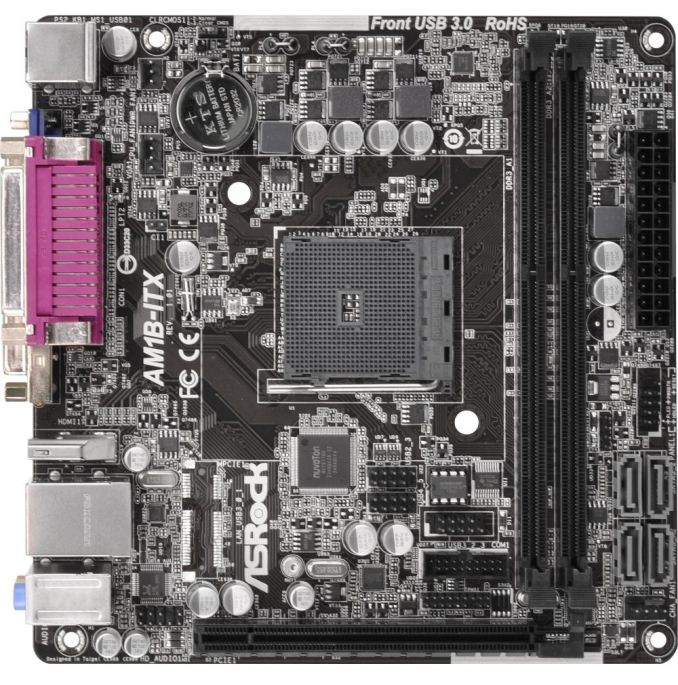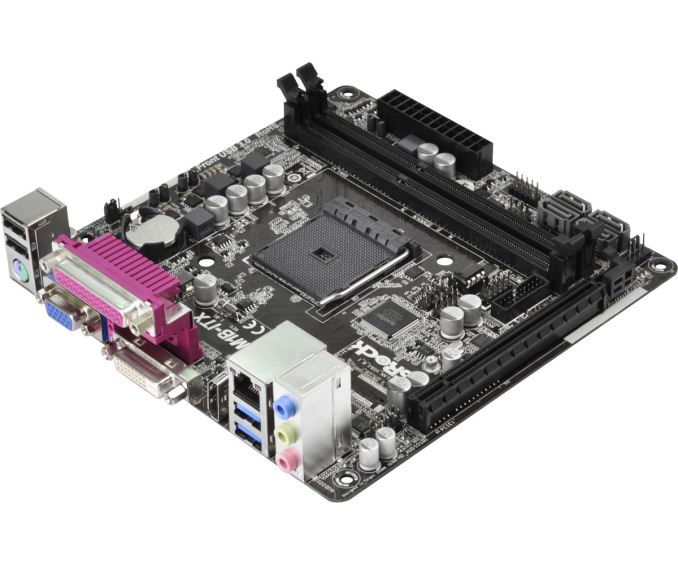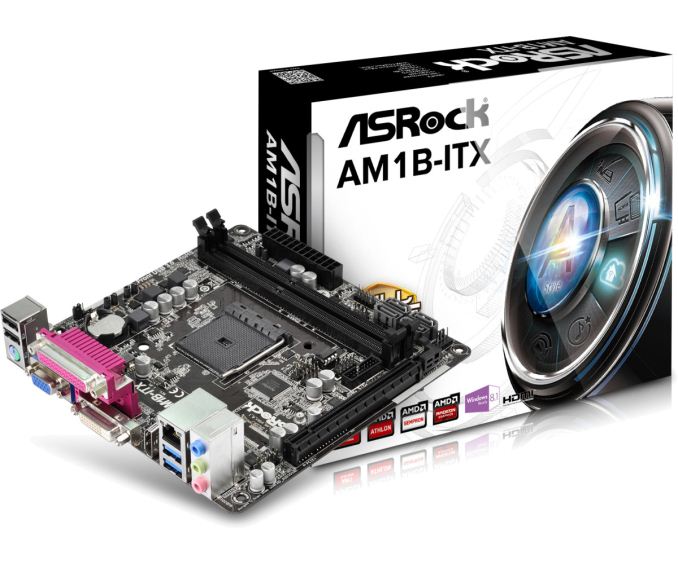The AM1 Kabini Motherboard Preview: Analyzing the Hardware
by Ian Cutress on April 19, 2014 2:00 PM ESTASRock AM1B-ITX
Moving to $40 and above brings a raft of changes – even by moving up a dollar does the AM1 landscape seem to change rapidly enough. To coin the eponymous phrase, ‘And now for something completely different’. The AM1B-ITX does what a motherboard above the base should do: add functionality and reduce complexity. Here we get double the SATA 6 Gbps ports and double the USB 3.0 ports, as well as three fan headers and an integrated parallel port on the rear panel whilst at the same time removing the need of a 4-pin CPU power connector.
ASRock has placed the 24-pin ATX connector, the four SATA 6 Gbps ports and the front panel header outside the DRAM slots (to the right), making cable management with this mini-ITX motherboard a lot easier. The SATA ports are also alternate facing to aid removal of locking SATA cables. Just inside the DRAM slots at the bottom are some of the additional headers – the COM header, the TPM header, the USB 3.0 header and two USB 2.0 headers. It might actually be a little too cramped in there.
Despite removing 4-pin CPU power connector, the top of the motherboard does look extremely busy with all the components on board. Two of the fan headers are in this area at the top left, while the third is at the bottom right. As with the other motherboards in this preview, the main PCIe 2.0 x16 slot runs at x4 mode due to the PCIe lane allocation, and of the lanes that are left ASRock has diverted one each to ASMedia controllers for the extra USB 3.0 and SATA 6 Gbps ports respectively.
While we lose the two extra USB 2.0 ports from the AM1B-M on the previous page, the rear panel gets access to more video outputs and a parallel port instead. When an antiquated port is added to a modern product, some users will bemoan its presence. More often than not, these are added because companies that use old equipment that communicates via the parallel port can cost six figures and is only updated once every few decades, so it is easier to update a $400 PC than a $400000 milling machine.
| ASRock AM1B-ITX | |
| Price | Link |
| Size | Mini-ITX |
| CPU Interface | FS1b |
| Chipset | Kabini |
| Memory Slots |
Two DDR3 DRAM slots, supporting 16 GB Single Channel, 1066-1600 MHz |
| Video Outputs |
VGA (2048x1536 at 60 Hz) DVI-D (1920x1200 at 60 Hz) HDMI (4096x2160 at 24 Hz or 3840x2160 at 30Hz) |
| Onboard LAN | Realtek RTL8111GR |
| Onboard Audio | Realtek ALC662 |
| Expansion Slots | PCIe 2.0 x16 (x4) |
| Onboard SATA/RAID |
2 x SATA 6 Gbps (Chipset) 2 x SATA 6 Gbps (ASMedia ASM1061) |
| USB 3.0 |
2 x USB 3.0 (Chipset) [back panel] 2 x USB 3.0 (ASMedia ASM1042A) [header] |
| Onboard |
4 x SATA 6 Gbps 1 x USB 3.0 Header 2 x USB 2.0 Headers 3 x Fan Headers 1 x COM Header 1 x TPM Header Front Audio Header Front Panel Header |
| Power Connectors | 1 x 24-pin ATX |
| Fan Headers |
1 x CPU (4-pin) 1 x CHA (4-pin) 1 x PWR (3-pin) |
| IO Panel |
1 x PS/2 Combination Port 1 x Parallel Port VGA DVI-D HDMI 2 x USB 2.0 2 x USB 3,0 1 x Gigabit Ethernet Audio Jacks (ALC662) |
| Product Page | Link |
Price wise, the ASRock AM1B-ITX blows the AM1B-M out of the water. For a few extra dollars there are more ports for more of the things most users will want. There is still the issue of that bottom-of-the-barrel Realtek ALC662 though.














64 Comments
View All Comments
coolhardware - Saturday, April 19, 2014 - link
Nice brief overview of the motherboards, wish there was some more meat to the article. I guess that comes later!I have the MSI AM1I with an Athlon 5350 and have been loving it. The MSI can actually do a slight CPU OC by setting the multiplier to 21x which gets the clock to 2.1GHz (as opposed to 2.05GHz stock) and it overclocked my 1333 memory to 1666 with no problem. Overall it's a sweet little board for the price!
Anybody else with other AM1 motherboards notice any OCing options?
I'm posting my experiences here: http://www.jdhodges.com/blog/amd-kabini-athlon-535...
Also, I want to find out if it can drive three displays (DVI+VGA+HDMI) and looking forward to trying some high-res output from the HDMI port. I doubt the DVI is dual link, but I plan to find out for sure by trying my trusty Dell 30" 2560x1600 display :-)
meacupla - Saturday, April 19, 2014 - link
does SODIMM DDR3L cost more to implement than desktop DDR3?All of these boards could have saved a ton of space by going with SODIMM, but none have.
Why?
MonkeyPaw - Saturday, April 19, 2014 - link
With the SOC taking on most of the work, the boards don't need to worry about space savings, as they still need to fit in the standard ITX/ATX form factors. I imagine the legacy DIMM slots are cheaper anyway. These boards are engineered for cheap, which is why you see 10/100, 2.1 audio, USB 2.0, or limited expansion options. If a better option was even 5 cents more, they probably skipped it. I'm surprised these things aren't white boxed!Voldenuit - Sunday, April 20, 2014 - link
Ian: is the Biostar mini-DTX (23x17 cm) instead of mini-ITX? I haven't heard of mini-ITX plus before.Voldenuit - Sunday, April 20, 2014 - link
Typo: Mini-DTX is 20.3x17cmElFenix - Monday, April 21, 2014 - link
the board is 19.1x17, so it fits within the mini-DTX size specification. however, biostar calls it micro atx on its website.geniekid - Tuesday, April 22, 2014 - link
It is mini-DTX, but I guess it shows how unpopular the spec is given that even an AT writer came up with his own term for it.IMO there's a lot of potential for mDTX for people who want compact systems without giving up a graphics card or their audio card.
yannigr - Sunday, April 20, 2014 - link
I hope there is an overclocking part coming in the future. I have seen a 5150 running at 2.1GHz(ASUS board). On the other hand at Phoronix they hit the wall at 105MHz bus for some reason.An article about overclocking, especially the Sempron, would have been great. There is a possibility that Sempron to be the second product from AMD that I will buy and will have a 3850 as a model number. I am just waiting for more info from around the net.
PS If kabinis where black edition chips AMD wouldn't be able to produce them fast enough.
coolhardware - Sunday, April 20, 2014 - link
MSI can run the 5150 at 2.1GHz as well, screenshots here:http://www.jdhodges.com/blog/amd-kabini-athlon-535...
Anybody seen more than 21x on a 5150? And do the lower end Kabini's overclock any?
yannigr - Monday, April 21, 2014 - link
It is NOT the 5150 in the test but the 5350. Look the link itself. It says 5350.MSI only seems to have the option to change the multiplier, not the bus speed. And the multiplier will give you extra 50MHz IF the APU has a multiplier with a .5 in it, like 5350 it has 20.5 multiplier. So you can change it to 21. If this was a 5150 with 16 multiplier you wouldn't be able to go any higher than that. Not a single MHz.
Thanks for the link anyway!